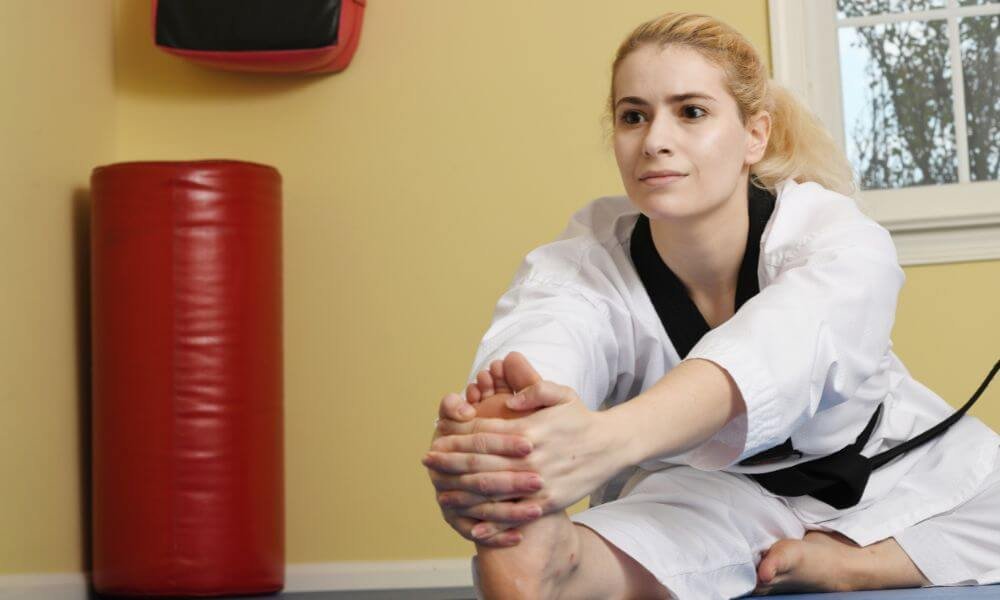Contents
- 1 How to Start Daily Exercise: A Comprehensive Guide to Building a Fitness Habit
- 1.1 Understanding the Importance of Daily Exercise
- 1.2 Key Benefits:
- 1.3 Setting Realistic Goals
- 1.4 Choosing the Right Type of Exercise
- 1.5 Crafting an Exercise Plan
- 1.6 Example Plan:
- 1.7 Making Exercise a Routine
- 1.8 Motivating Factors for Consistency
- 1.9 Overcoming Common Barriers
- 1.10 Assessing Progress and Adjusting Goals
- 1.11 10 Life-Changing Effects of Daily Exercise
- 1.12 1. Enhanced Cognitive Function
- 1.13 2. Boosts Creativity
- 1.14 3. Better Sleep
- 1.15 4. Enhanced Emotional Resilience
- 1.16 5. Improved Social Life
- 1.17 6. Better Financial Management
- 1.18 7. Environmentally Friendly
- 1.19 8. Enhanced Career Performance
- 1.20 9. Lower Healthcare Costs
- 1.21 10. Positive Family Dynamics
How to Start Daily Exercise: A Comprehensive Guide to Building a Fitness Habit
Introduction:
It is becoming increasingly common in the United States to lead a sedentary lifestyle, which is one factor that contributes to a variety of health problems, including obesity, diabetes, and cardiovascular diseases. The Centers for Disease Control and Prevention (CDC) reports that only 23 percent of Americans get the amount of exercise recommended to be done each week (CDC, 2018).
There is no better time than the present to take action, especially if you are one of the 77% of people not meeting these goals. In this piece, we’ll review your steps to establish a consistent daily exercise routine.

Understanding the Importance of Daily Exercise
- Regular physical activity has numerous health benefits, including cardiovascular and mental well-being improvements. (American Heart Association, 2019) One study by the American Heart Association found that adults who participated in physical activity for 150 minutes per week at a moderate intensity had a 31% lower risk of passing away before their natural time.
Key Benefits:
- Weight management
- Lower risk of chronic diseases
- Improved mental health
- Enhanced quality of life
Setting Realistic Goals
- Goals that are too vague or too unrealistic almost always fail. Instead of focusing on abstract goals such as “getting fit,” you should aim for SMART goals, which stand for specific, measurable, attainable, relevant, and time-bound objectives.
Example SMART Goal:
“I will walk 30 minutes daily, five times a week, for the next four weeks.”

Choosing the Right Type of Exercise
- When it comes to physical activity, there is no “one-size-fits-all” approach. Your decision ought to be influenced by factors such as your goals, level of physical ability, and interests. Among the most popular choices in the United States are:
- Cardiovascular: Running, swimming, cycling
- Strength Training: Weightlifting, resistance bands, bodyweight exercises
- Flexibility: Yoga, Pilates
- Sport-based: Basketball, soccer, tennis
Crafting an Exercise Plan
- After determining what kind of physical activity works best for you, the next step is to devise an exercise regimen for yourself. Websites like MyFitnessPal and mobile applications like Strava provide users with individualized workout programs tailored to their specific requirements.
Example Plan:
- Monday: Cardio (30 minutes)
- Tuesday: Strength Training (20 minutes)
- Wednesday: Rest or light yoga
- Thursday: Cardio (30 minutes)
- Friday: Strength Training (20 minutes)
- Weekend: Rest or outdoor activities
Making Exercise a Routine
Consistency is the name of the game when it comes to getting daily exercise. The following are some suggestions that can help you work exercise into your daily routine:
- Schedule It: Every day, commit to a particular time.
- Start Small: Avoid putting too much pressure on yourself. Start with sessions that are shorter and easier to handle.
- Accountability: Do your workouts with a buddy or family member.

Motivating Factors for Consistency
The ability to maintain a routine of daily physical activity requires motivation. The following are some examples of effective strategies:
- Tracking Progress: Tracking your progress can be done with the help of apps or a journal.
- Reward System: After accomplishing a significant goal, you deserve a reward.
- Social Support: Participate in neighborhood workout groups or online fitness communities.
Overcoming Common Barriers
The path toward consistent physical activity is frequently fraught with challenges. The most common obstacles and how to overcome them are as follows:
- Time: Make time for physical activity by employing various time management methods.
- Boredom: Add some flavor by switching up the activities or trying something completely different.
- Cost: Use the free resources available online, or concentrate on exercises that only require your body weight as resistance.
Assessing Progress and Adjusting Goals
- It is essential to assess how far you have come after a few weeks have passed. If you want to monitor your progress, you could use fitness trackers or straightforward methods of self-evaluation. Adjust your initial goals if they are too simple or challenging to achieve.

10 Life-Changing Effects of Daily Exercise
The transformative power of regular exercise extends to every aspect of one’s life, but it is most commonly praised for its positive effects on one’s physical health. In addition to the material covered, here are ten compelling ways in which regular physical activity can significantly improve your life.
1. Enhanced Cognitive Function
- As research has shown, memory, attention, and other cognitive functions can benefit from regular physical activity. Research recently published in the Journal of Clinical Psychology (Smith et al., 2010) shows that regular physical activity can slow the cognitive decline of advancing age.
2. Boosts Creativity
- It’s possible that a productive run or swim could be the key to unlocking your full creative potential. Believe it or not. According to a recent study (Oppezzo & Schwartz, 2014), people typically experience a surge in their creative output during and after physical activity.
3. Better Sleep
- Regular exercise has been shown to improve sleep quality and duration, which are essential to good health. Aerobic exercise, even for 10 minutes, can significantly enhance sleep quality, according to the National Sleep Foundation (National Sleep Foundation, 2018).
4. Enhanced Emotional Resilience
- Getting at least 30 minutes of exercise daily can strengthen you mentally and more resilient to stress and other psychological challenges. According to a study recently published in Health Psychology (Childs & de Wit, 2014), engaging in physical activity acts as a buffer against the adverse effects of stress.
5. Improved Social Life
- Participating in organized sports or joining a sports club can help you improve your social skills and expand your network. Not only is it an excellent way to make new friends, but it also helps to cultivate a sense of teamwork and responsibility toward the community.

6. Better Financial Management
- Surprisingly, the self-control that one acquires through consistent physical activity can directly translate into improved financial management. Maintaining a workout routine requires careful preparation and the ability to postpone gratification, which can help you become a more astute manager of your money.
7. Environmentally Friendly
- Selecting workouts that don’t require machinery or apparatus benefits your bank account and the natural world. Physical activities such as walking, jogging, and yoga are all good for the environment.
8. Enhanced Career Performance
- The improved self-discipline, stress management skills, and cognitive function from regular physical activity can significantly impact your professional performance. In the business world, skills like these that are easily transferable are highly valued.
9. Lower Healthcare Costs
- Regular physical activity improves health and lowers medical care and treatment costs. According to the American Heart Association, inactivity costs the healthcare system an estimated $117 billion annually (American Heart Association, 2020).
10. Positive Family Dynamics
- Regular physical activity as a family can help to strengthen relationships, provide opportunities for shared experiences, and contribute to a heightened sense of collective well-being. When a family works out together, they are more likely to stick together.
You can gain much more than just physical fitness by integrating exercise into your daily routine. From cognitive and emotional enhancements to social and even financial benefits, the transformative power of daily exercise is beyond compelling. Make the choice today to embrace this life-changing habit.

Summary and Conclusion:
In this manual, we’ve covered the basics of making exercise a regular part of your life, how it can benefit you (physically, mentally, and even monetarily), and the best practices for ensuring you stick with it. We have also explored the lesser-known but equally profound and game-changing effects of regular physical activity on every aspect of your life.
There may be challenges to making exercise a daily habit, such as lack of time or interest, but the benefits are too great to pass up. The journey becomes much more manageable when you’re prepared with SMART goals, a diverse exercise plan tailored to your needs, and an understanding of how this simple yet profound change can enhance your life in ways you might not have imagined.
If you follow the advice in this guide, you won’t just be adding another thing to your schedule; you’ll be significantly improving your quality of life.
- Concluding Remarks
Now, more than ever, it is essential that we put our emotional and physical well-being first. When you start moving, you’ll be on your way to a happier, healthier life. The advantages extend beyond the individual and benefit our communities, societies, and planet. Stop procrastinating and take that all-important first step toward a more active lifestyle by lacing up your sneakers and committing to an exercise routine today.

References
(Centers for Disease Control and Prevention. (2018). Only 1 in 4 Americans Get Enough Exercise. Retrieved from CDC website
American Heart Association. (2019). Benefits of Physical Activity. Retrieved from American Heart Association website
Disclaimer: This article is for informational purposes only and should not replace professional medical advice.)
By following this comprehensive guide, you’ll be well on your way to making daily exercise an integral part of your lifestyle. The first step is always the hardest, but you’ll find it increasingly more accessible and rewarding with a solid plan and consistent effort. So, tie up those sneakers and take the first step today! (Smith, P. J., Blumenthal, J. A., Hoffman, B. M., Cooper, H., Strauman, T. A., Welsh-Bohmer, K., … & Sherwood, A. (2010). Aerobic exercise and neurocognitive performance: a meta-analytic review of randomized controlled trials. Journal of Clinical Psychology, 67(3), 301-319.
Oppezzo, M., & Schwartz, D. L. (2014). Give your ideas some legs: The positive effect of walking on creative thinking. Journal of Experimental Psychology: Learning, Memory, and Cognition, 40(4), 1142-1152.
National Sleep Foundation. (2018). How Does Exercise Help Those With Chronic Insomnia? Retrieved from National Sleep Foundation website
Childs, E., & de Wit, H. (2014). Regular exercise is associated with emotional resilience to acute stress in healthy adults. Frontiers in Physiology, 5, 161.
American Heart Association. (2020). The Price of Inactivity. (Retrieved from American Heart Association website.)









